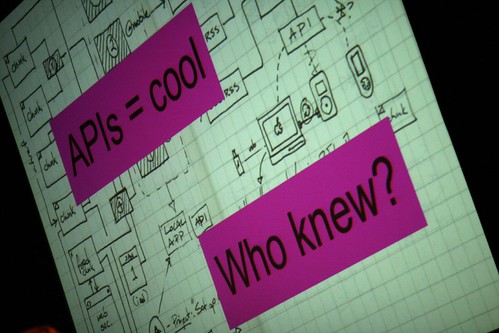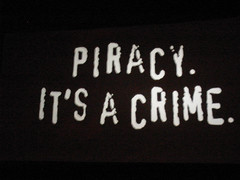Application Programming Interfaces – better known in the technology industry as API’s – have come out as one of the most significant innovations in information technology. What at first appears a geeky technical technique for developers to play with, is now evolving into something that will underpin our very society (assuming you accept information has, is, and will be the the crux of our society). This post explores the API and what it means for business.
What is it?
In very simple terms, an API is a set of instructions a service declares, that outsiders can use to interact with it. Google Maps has one of the most popular API’s on the Internet and provides a good example of their power. Google hosts terabytes of data relating to its mapping technology, and it allows developers not affiliated with Google to build applications on top of Google’s. For example, thousands of websites like the NYTimes.com have integrated Google’s technology to enhance their own.
An example more familiar with ordinary consumers would be Facebook applications. Facebook allows developers through an API to create ‘apps’ that have become one of the main sources of entertainment on Facebook, the world’s most popular social networking site. Facebook’s API determines how developers can build apps that interact with Facebook and what commands they need to specify in order to pull out people’s data stored in Facebook. It’s a bit like a McDonald’s franchise – you are allowed to use McDonald’s branding, equipment and supplies, so long as you follow the rules in being a franchisee.
API’s have become the centre of the mashup culture permeating the web. Different websites can interact with each other – using each others technology and data – to create innovative products.
What incentive do companies have in releasing an API?
That’s the interesting question that I want to explore here. It’s still early days in the world of API’s, and a lot of companies seem to offer them for free – which seems counter-intuitive. But on closer inspection, it might not. Free or not, web businesses can create opportunity.
Free doesn’t mean losing
An API that’s free has the ability to generate real economic value for a new web service. For example, Search Engine Optimisation (SEO) has become a very real factor in business success now. Becoming the top result for the major search engines generates free marketing for new and established businesses.
In order for companies to boost their SEO rankings, one of the things they need to do is have a lot of other websites pointing links at them. And therein flags the value of an open API. By allowing other people to interact with your service and requiring some sort of attribution, it enables a business to boost their SEO dramatically.
Scarcity is how you generate value
One of the fundamental laws of economics, is that to create value, you need something to be scarce. (That’s why cash is tightly controlled by governments.) Twitter, the world’s most popular micro-blogging service, is famous for the applications that have been built on their API (with over 11,000 apps registered). And earlier this year, they really got some people’s knickers in a knot when they decided to limit usage of the API.
Which is my eyes was sheer brilliance by the team at Twitter.
By making their API free, they’ve had hundreds of businesses build on top of it. Once popular, they could never just shut the API off and start charging access for it – but by introducing some scarcity, they’ve done two very important things: they are managing expectations for the future ability to charge additional access to the API and secondly, they are creating the ability to generate a market.
The first point is better known in the industry as the Freemium model. Its become one of the most popular and innovative revenue models in the last decade on the Internet. One where it’s free for people to use a service, but they need to pay for the premium features. Companies get you hooked on the free stuff, and then make you want the upgrade.
The second point I raised about Twitter creating a market, is because they created an opportunity similar to the mass media approach. If an application dependent on the API needs better access to the data, they will need to pay for that access. Or why not pay someone else for the results they want?
Imagine several Twitter applications that every day calculate a metric – that eats their daily quota like no tomorrow – but given it’s a repetitive standard task, doesn’t require everyone having to do it. If the one application of say a dozen could generate the results, they could then sell it to the other 11 companies that want the same output. Or perhaps, Twitter could monitor applications generating the same requests and sell the results in bulk.
That’s the mass media model: write once, distribute to many. And sure, developers can use up their credits within the limit…or they can instead pay $x per day to get the equivalent information pre-mapped out. By limiting the API, you create an economy based on requests (where value comes through scarcity) – either pay a premium API which gives high-end shops more flexibility or pay for shortcuts to pre-generated information.
API’s are part of the information value chain
An economic concept I proposed a year ago (and am going to revise over the coming year with some fresh thought) is called the Information Value Chain. It takes an established economic theory that has dictated business in the industrial age, and applies it in the context of businesses that create products in information or computing utility.
With reference to my model, the API offers the ability for a company to specialise at one stage of the value chain. The processing of data can be a very intensive task, and require computational resources or raw human effort (like a librarian’s taxonomy skills). Once this data is processed, a company can sell that output to other companies, who will generate information and knowledge that they in turn can sell.
I think this is one of the most promising opportunities for the newspaper industry. The New York Times last year announced a set of API’s (their first one being campaign finance data), that allows people to access data about a variety of issues. Developers can then query this API, and generate unique information. It’s an interesting move, because it’s the computer scientists that might have found a future career path for journalists.
Journalists skills in accessing sources, determining significance of information, and conveying it effectively is being threatened with the democratisation of information that’s occurred due to the Internet. But what the NY Times API reflects, is a new way of creating value – and it’s taking more of a librarian approach. Rather than journalism become story-centric, their future may be one where it is data based, which is a lot more exciting than it sounds. Journalists yesterday were the custodians of information, and they can evolve that role to one of data instead. (Different data objects connected together, by definition, is what creates information.)
A private version of the semantic web and a solution for data portability
The semantic web is a vision by the inventor of the World Wide Web, which if fully implemented, will make the advances of the Internet today look like prehistory. (I’ve written about the semantic web before to give those new to the subject or skeptical.) But for those that do know of it, you probably are aware of one problem and less aware of another.
The obvious problem is that it’s taking a hell of a long time to see the semantic web happen. The not so obvious problem, is that it’s pushing for all data and information to be public. The advocacy of open data has merit, but by constantly pushing this line, it gives no incentive for companies to participate. Certainly, in the world of data portability, the issue of public availability of your identity information is scary stuff for consumers.
Enter the API.
API’s offer the ability for companies to release data they have generated in a controlled way. It can create interoperability between different services in the same way the semantic web vision ultimately wants things to be, but because it’s controlled, can overcome this barrier that all data needs to be open and freely accessible.
Concluding thoughts
This post only touches on the subject. But it hopefully makes you realise the opportunities created by this technology advance. It can help create value without needing to outlay cash; new monetisation opportunities for business; additional value in society due to specialisation; and the ability to bootstrap the more significant trends in the Web’s evolution.









